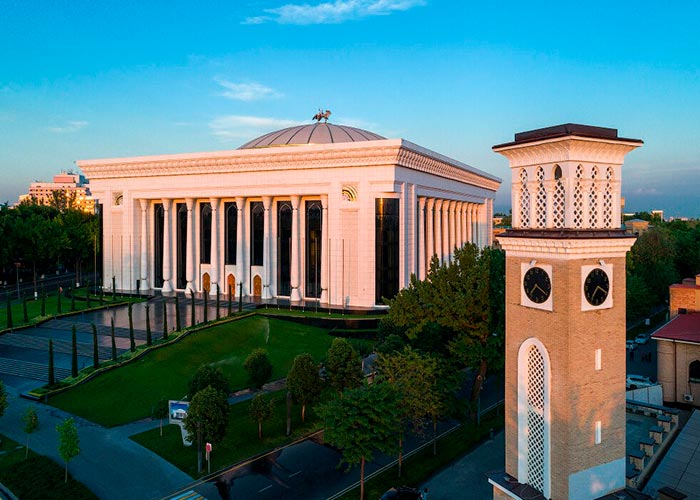


Kukeldash Madrasah
"Death is an inevitable human,
His works, however, are timeless because he created them.
Tashkent is famous for its historical sights. One of the biggest attractions is the Kukeldash Madrassah, which was built in 1569.
His works, however, are timeless because he created them.
Tashkent is famous for its historical sights. One of the biggest attractions is the Kukeldash Madrassah, which was built in 1569.
The idea of building Kukeldash belongs to Dervish Khan, the ruler of Tashkent Province. Vizier Dervish Khan had a second name, Kukeldash (foster brother). In his honor, this historic facility was erected. However, initially, it carried a completely different purpose than it does today.
It was decided to build a madrassah close to the present bazaar of Chorsu. At that time, as now, this place was the historic center of Tashkent. Construction lasted one year. In 1570, the madrassa became a central part of the ensemble of the square. By the way, this place was the Kesh gates.
In those years, the madrassah was considered a kind of fortress for all the khans, which also accomplished public execution for unfaithful wives.
Kukeldash madrassah in Tashkent was made with bricks, with hudzhuras, a courtyard, and a darsahanom (special study room). There is also a mosque attached to it.
The entrance of the madrassah was built with corner towers and a two-tier balcony reaching a height of 19.7 meters. The facade was decorated with special glaze bricks, mosaics, and lattice windows where the names of the Prophet Muhammad and Allah were written.
Every cell in the Kukeldash consisted of one room and quinces for a small group of students, three or four people.
On one of the walls of the historic monument was carved the inscription: "Death is inevitable, but work made by them remains forever." If you are very careful and have good eyesight, you can see it.
The Kukeldash madrassah in Tashkent was reconstructed many times. Enemies attack, Tashkent revolts, a few strong earthquakes. Some parts of the madrassah were disassembled and reassembled brick by brick.
But that is not all. Since the mid-20th century, the madrassah has been used for strange, inherently exhibitions. For example, one of them promoted an atheistic lifestyle. For a long time, Kukeldash madrassah was a museum of national instruments.
In the years after the independence of Uzbekistan, Kukeldash madrassah began to be used for other purposes. It was restored in the '80s with angular towers that called the faithful to prayer.
Our travel agency, "Orient Mice," will be happy to provide you with transport, hotel, and professional guides who will show you not only the city, but also tell you amazing stories about the architectural monuments of Tashkent.
It was decided to build a madrassah close to the present bazaar of Chorsu. At that time, as now, this place was the historic center of Tashkent. Construction lasted one year. In 1570, the madrassa became a central part of the ensemble of the square. By the way, this place was the Kesh gates.
In those years, the madrassah was considered a kind of fortress for all the khans, which also accomplished public execution for unfaithful wives.
Kukeldash madrassah in Tashkent was made with bricks, with hudzhuras, a courtyard, and a darsahanom (special study room). There is also a mosque attached to it.
The entrance of the madrassah was built with corner towers and a two-tier balcony reaching a height of 19.7 meters. The facade was decorated with special glaze bricks, mosaics, and lattice windows where the names of the Prophet Muhammad and Allah were written.
Every cell in the Kukeldash consisted of one room and quinces for a small group of students, three or four people.
On one of the walls of the historic monument was carved the inscription: "Death is inevitable, but work made by them remains forever." If you are very careful and have good eyesight, you can see it.
The Kukeldash madrassah in Tashkent was reconstructed many times. Enemies attack, Tashkent revolts, a few strong earthquakes. Some parts of the madrassah were disassembled and reassembled brick by brick.
But that is not all. Since the mid-20th century, the madrassah has been used for strange, inherently exhibitions. For example, one of them promoted an atheistic lifestyle. For a long time, Kukeldash madrassah was a museum of national instruments.
In the years after the independence of Uzbekistan, Kukeldash madrassah began to be used for other purposes. It was restored in the '80s with angular towers that called the faithful to prayer.
Our travel agency, "Orient Mice," will be happy to provide you with transport, hotel, and professional guides who will show you not only the city, but also tell you amazing stories about the architectural monuments of Tashkent.


